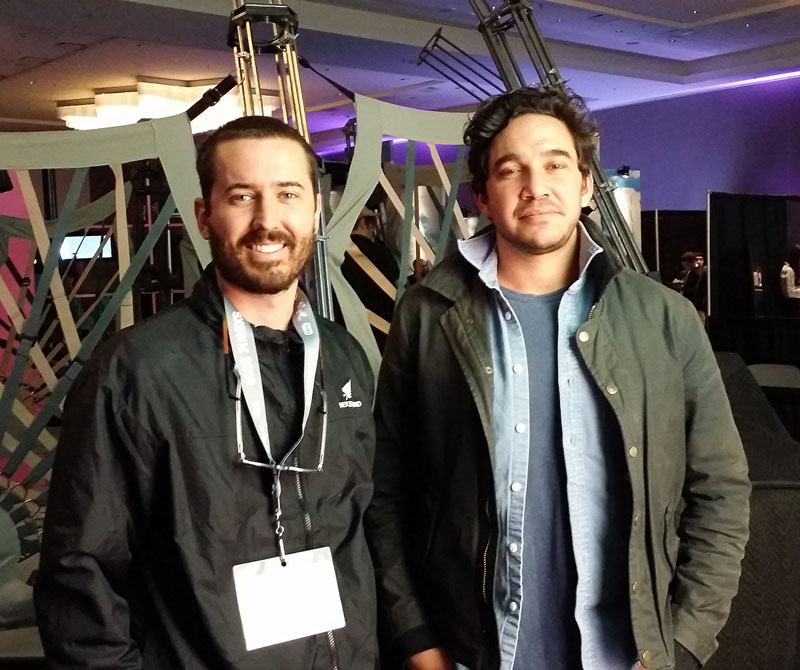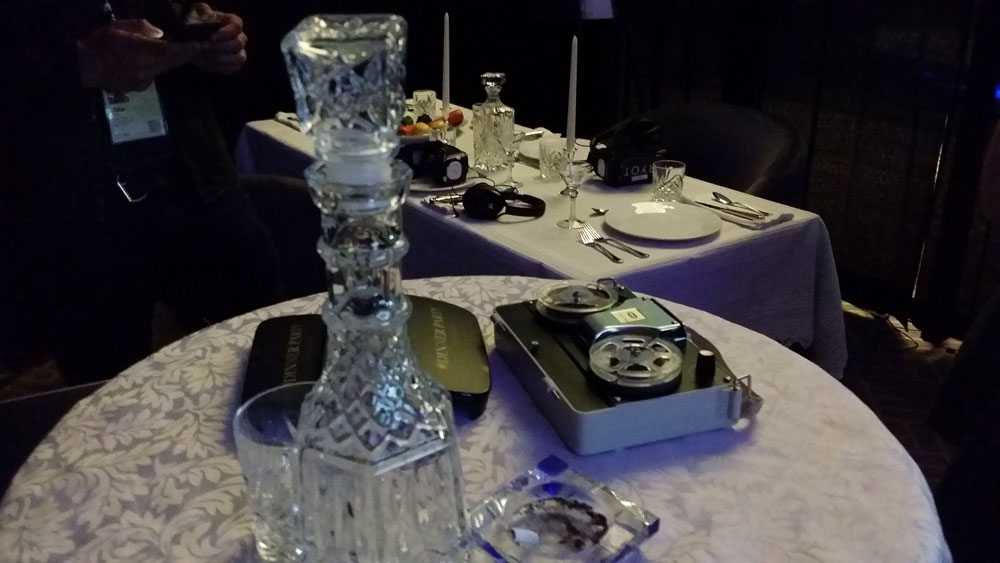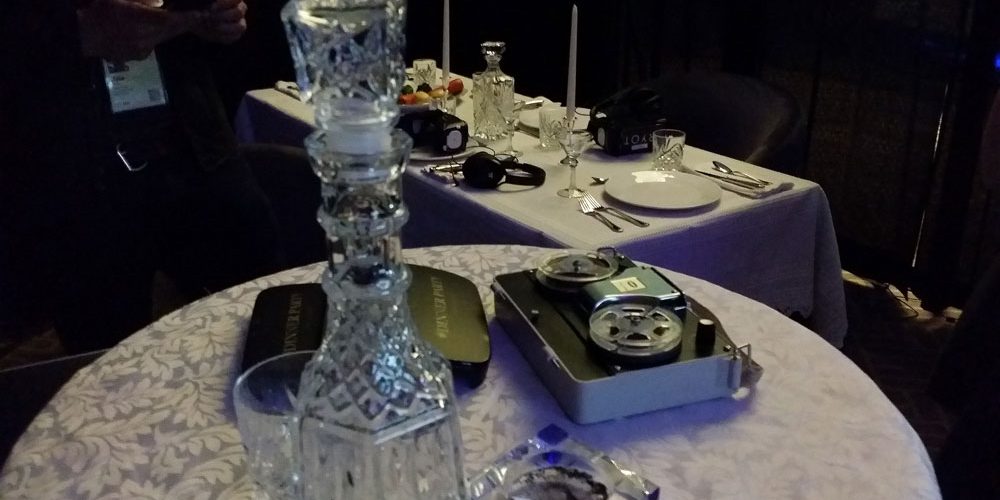
Among the more intriguing offerings at this year’s SXSW was the Virtual Cinema space at the JW Marriott. There, attendees had the opportunity to experience the next wave of immersive cinema. I was invited to view Telexist‘s VR thriller Dinner Party and interview one of the company’s founders, Sam Gezari. It made for quite a memorable morning.
Dinner Party is based on the true story of Betty and Barney Hill, an interracial couple who reported America’s first-known alien abduction incident in 1961. Undergoing hypnosis to recover memories of their experience, they play back the recordings at a dinner party, and it all comes flooding back. The viewer is transported into the story in a completely immersive and striking fashion.
Gezari is an eager proponent of VR storytelling. Here, he talks about the creative process and where he sees the technique going in the future.
Talk about the origins of your company.
[Telexist co-founder Erik Donley] and I started out in traditional filmmaking. We began literally in my home studio and moved into a basement apartment. It kept growing from three to five to eight people. Now we’re in a studio in mid-city Los Angeles that has enough space for us to continue to grow. We’re all working on really specific projects. We have people who are only stitching, painting and rotoscoping, 3D modeling, world-building, and so on.I think that the origin stories are really just driven by our need to find a way to do it. There was really nobody out there who was doing it on a small scale. There are a couple of companies out there doing this that are just massive, and here we are taking on this type of work. We wanted to get going, build the momentum and create the types of projects we wanted to. We had to go out and find these individuals who were excited about it and wanted to come on board and make that stuff happen.
And it’s a specialty that you don’t go to school to learn.
Exactly. About half of the people who work with us are trained in general VFX, specifically 3D modeling. Because the software is constantly changing, when we need a tool that doesn’t exist yet, we end up working with the company that makes that software. It’s user-driven creative toolmaking!
On Dinner Party, for instance, we encountered things that I think had never been done before — combining 3D particle work with 3D live capture, putting those two things together and making them seamless and integrated. At every other turn, there’d be an obstacle we’d face. There’s no edit board out there, no solution, no documentation on how you can do this stuff. So a lot of it, even the really technical stuff, is incredibly creative. These artists are technicians — really creative technicians. it requires thinking outside the box.
They probably loved the challenges.
So much. They probably hated them as well. A two-month turnaround on a project like this is absolutely unheard of, and something we won’t do again, just in terms of our own sanity. The project’s something we’re very proud of, however.
Unwittingly, we created a VFX house. Every frame of a film is VFX, and that’s something that wasn’t entirely clear in the beginning. We’re using incredibly complex software, lots of really robust computers. You’re taking a series of flat planes, distorting them and blending the edges to create a seamless image. We’re bringing together a lot of different capture methods and changing the way post is done.
A lot of times you see VR projects in which people will change the creative to serve the technology, but creative is king. Telling the story in narrative VR is what we’re focused on doing. Everything we do from a technical standpoint is to serve the creative and not the other way around. It’s our mantra.
We have 130 years of filmmaking under our belt. All that visual language can be applied to this new medium. Plus there’s the added advantage of the kind of user experience — the viewer integration. There’s a symbiotic relationship between the viewer and what they’re watching. A lot of the VR content we’ve seen thus far is still a traditional film, just forced into a VR headset. I think really utilizing what virtual reality has to offer means making the viewer part of the storytelling process.
Emerging technology — art, science — is actually the future of this medium. Creating empathy and making people feel things is what good storytelling does. This medium already does that because of the forced focus, surrounding you with images in the same way that we live our lives. It’s already good at creating emotional content. We just need to have a smarter way to tell the stories and let the medium work for us.
In the process of developing this storytelling, do you have proprietary programs you’ve created?
Yes. That’s a big part of it. There’s a lot of open source software out there, a lot of tools available to us. We have developed some of this technology. It’s in the background, hidden behind the story. It’s not nefarious in any way. It allows us to have a better understanding of what people are seeing and how they’re watching things. That’s why VR has this amazing potential.

Dinner Party is part of a series, right?
It’s part of a series called The Incident which is currently ten episodes, maybe more. They’re all based on true stories of paranormal incidents. For that reason, they work really well. There’s something special about Dinner Party. It’s a really good story. It’s something that, when it came across our desk, we really wanted to make. It’s really cinematic. It has what you look for in a VR project, which is a good story and really strong visual potential. Too often, I think you only see one or the other.
Obviously this new technology requires new distribution methods. What do you have lined up for The Incident?
There’s definitely a lot of interest and potential. Ideally, it would be a platform that would allow it to be seen as widely as possible. In this instance, this is a passive VR film. There is no interactivity; there is no user-influenced storytelling, but it’s shot in such a way that mimics the films we admire and look to for inspiration. It’s all one shot using Technocrane, so the camera glides through the world, and you’re present during all these intimate moments without a need for a reason why you’re there. Moving through this world and different points in time makes it feel very authentic.
Are there any other out-of-the-box projects you’re working on?
Yes, a couple of projects, including one called Memory Palace, which was just announced in the trades a couple of weeks ago. It’s a neo-noir crime thriller set in the near future. Our main protagonist is a recently-disbarred lawyer whose wife was mysteriously murdered. He is on a quest for revenge and to seek the truth behind who did it.
As the viewer, you’re his sixth sense. He’s got a kind of a truth-telling ability. He’s a bit of a human polygraph. The way it’s filmed is incredibly cinematic — live capture in a lot of cases combined with the techniques I mentioned. It’s awfully interactive. You actually enter into his memory palace. Through the clues you’ve collected by watching the film, you access more storylines, see more indepth coverage, learn more about the characters and so on.
This particular project is designed not just for HMDs and interactive headsets but is actually designed to be viewed on any screen so you can have a cinematic experience wherever you watch this. If you have advanced headsets, you get more interactivity and motion-sensing capability. You can interact with it. AR elements have also been designed for mobile devices which allow geotech, so you can find clues out in the real world. We’ve even incorporated voice activated software, so if you have an Alexa or Google Home, that story actually continues on those devices. It’s multiplatform, multidimensional storytelling.







